Should you force feed your cat? It’s a difficult question to answer. Force feeding can be dangerous, so it’s essential to weigh up the pros and cons before making any decisions. In this blog post, we’ll discuss the risks and benefits of force feeding your cat and explore alternative options that may be more effective in providing them with the nutrients they need.
Force feeding requires either a syringe or tube to introduce food directly into the stomach or intestines. While it may seem like an easy solution, there are potential dangers associated with this method.
For instance, if done incorrectly, it could result in injury or even death due to choking or aspiration pneumonia. Additionally, force feeding can cause anxiety for both pet and caregiver which can lead to further health issues later on.
On the other hand, there are certain advantages that come with forcibly feeding cats in certain situations. When done correctly by a qualified professional or experienced pet owner, it will provide much-needed nutrition when all else fails. Also, it can help cats regain their appetite after an illness or surgery so they can return to eating on their own.
Before deciding whether to force feed your cat, consider all of the risks and benefits involved as well as alternate options such as providing different types of food or adding supplements to their diet.
With careful consideration and expert guidance from a specialist, you can make an informed decision that is best for both you and your pet’s wellbeing.
What is Force Feeding?
Although it’s not recommended to force feed your cat, there are times when it may be necessary to ensure they’re getting the right nutrients for their health. In this blog post, we’ll explore what force feeding is, when it’s helpful, and how to do it safely.
Force feeding is the process of making a cat eat food against its will. This is typically done when the cat is unable or unwilling to eat on their own, and the goal is to make sure they are getting the nutrition they need to survive.
There are various methods of force feeding, including syringe feeding, the use of feeding tubes, and manual feeding with tools such as a spoon or syringe.
Each method has its own benefits and drawbacks, so choosing the right one for your cat will depend on factors like their condition, hydration level, and type of food being fed.
Force feeding is usually recommended in cases where the cat has lost significant weight, has suddenly become ill, or is recovering from surgery.
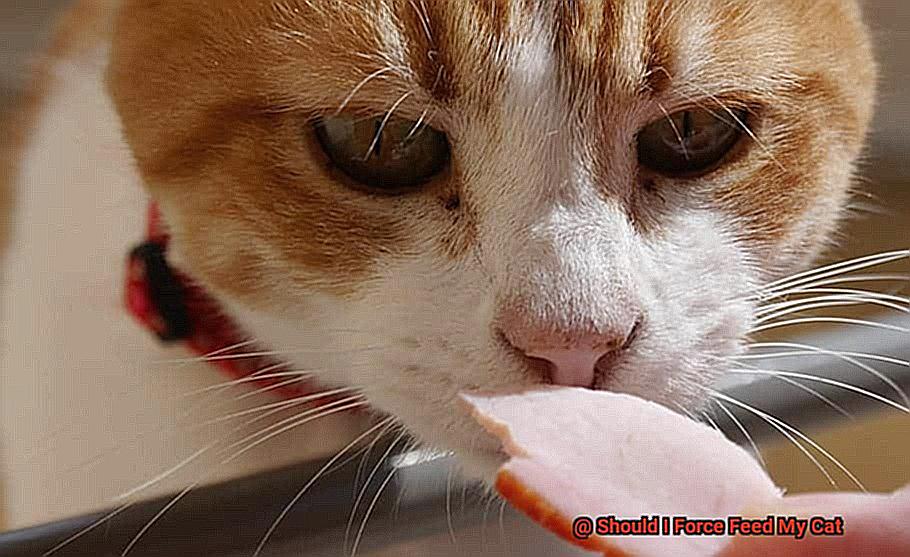
It’s important to keep in mind that force feeding should only be done under the supervision of a veterinarian, and only after other options have been exhausted. Attempting to force feed your cat at home without proper guidance can be dangerous and could lead to further health complications.
Before attempting to force feed your pet feline friend, it’s important to understand the underlying cause of their loss of appetite. This could be a symptom of an underlying health condition or an effect from medication; identifying the root cause is essential in addressing the issue properly.

When Should You Force Feed Your Cat?
It’s essential to pay close attention to your cat’s eating habits since they are an indicator of their overall health. If your cat stops eating, the first thing you should do is visit the vet in order to rule out any underlying medical conditions.
In some cases, force feeding might be necessary, but it should only be done under the guidance of a veterinarian.
Force feeding may be recommended if your cat undergoes surgery and isn’t eating or drinking on their own. In this case, it’s imperative to follow your vet’s instructions regarding the amount and frequency of force-feeding.
Additionally, if your cat is suffering from a severe illness such as liver disease, kidney failure, or cancer, force feeding could be necessary in order to supplement their nutritional needs. Your vet may prescribe a specially formulated food or a high-calorie diet for this purpose.
It’s important to remember that force-feeding should not be used as a long-term solution as it can lead to further health complications like esophageal damage, behavioral issues or refusal to eat independently.
As a pet owner, you need to address any underlying condition as soon as possible and take steps such as keeping your cat’s water and food dishes clean and creating an inviting meal environment in order to encourage them to eat independently and reduce the need for force feeding.
Ultimately, force feeding should only be done under veterinary supervision when all other options have been exhausted.
How to Gently Encourage Eating
Variety
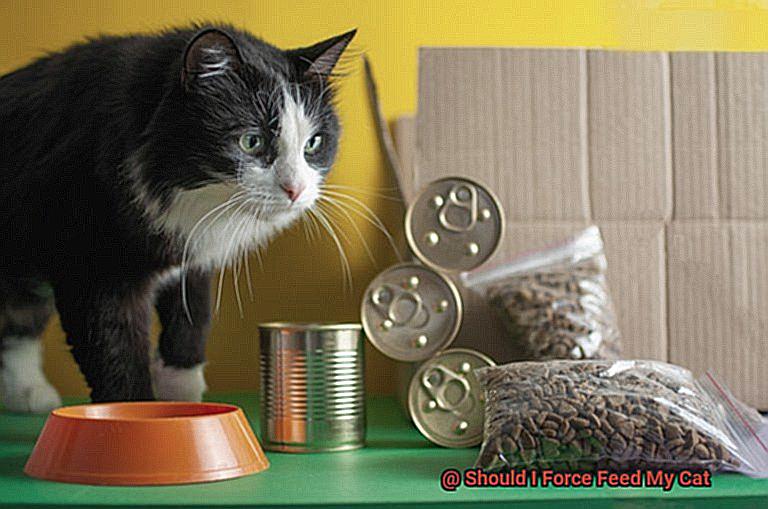
Spice up your Cat’s Plate. To encourage your cat to eat, try offering a variety of foods. Mixing in a small portion of their favorite dish with their regular meal can help make meals more enticing and encourage eating.
Warm it Up
Cats are more likely to eat food that is warm and smells appetizing. To make it more inviting, try warming up their food slightly in the microwave or adding warm water.
Hand Feed is a Mealtime Special Offering food by hand can be an effective way to get a cat to eat. Many cats may be more willing to eat if they feel secure and comfortable in their environment, plus it’s an opportunity for some quality bonding time with your furry friend.
Make Every Bite Count
Adding food toppers or gravy to their dish will make it more attractive for them to eat and provide extra nutrients. With every bite, you’re giving them an extra boost of deliciousness.
Let the Games Begin
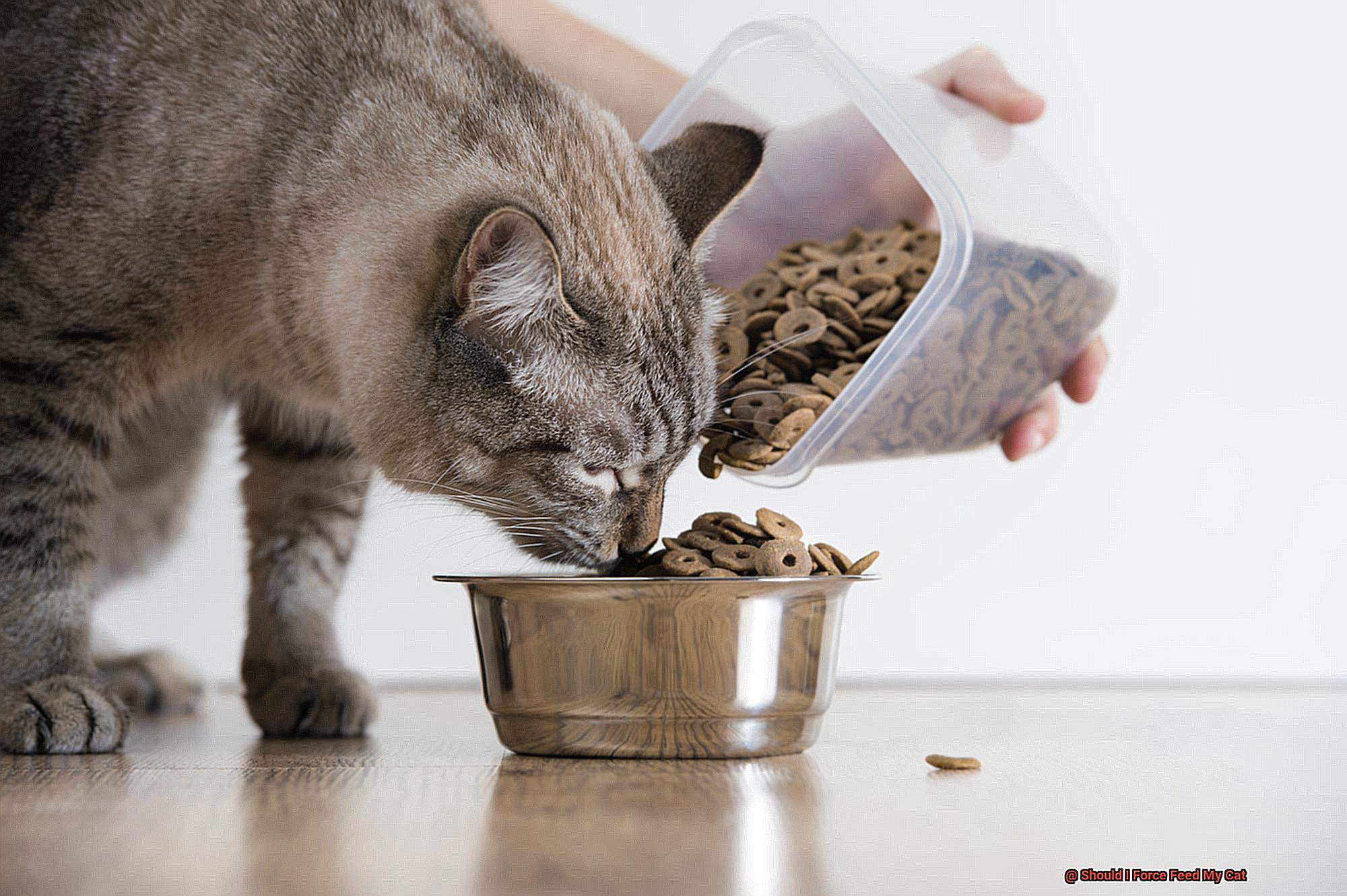
Make Mealtime Fun. Cats may be more likely to eat if they associate feeding time with something positive and enjoyable.
The Risks of Force Feeding
Force feeding a sick or dying cat can be a difficult decision for pet owners, as it comes with a range of potential risks.
It is essential to note that force feeding should only be done under the supervision of a veterinarian and as a last resort.
Force feeding can create stress and anxiety in cats, resulting in behavior problems and further health issues. Additionally, if the food is not digested correctly, it may lead to gastrointestinal issues such as vomiting, diarrhea, and even pancreatitis.
In extreme cases, force feeding may cause esophageal damage, aspiration pneumonia, or choking if the food is not administered properly.
It is also important to consider the ethical implications of force feeding.
Although it can temporarily keep your cat alive, it is not a long-term solution and may not necessarily improve their quality of life. In some cases, it may even prolong suffering.
Therefore, it is imperative to have open discussions with your vet about your options and make decisions based on what is best for your cat’s health and well-being.
Before resorting to force feeding there are many other choices that can be explored such as appetite stimulants, anti-nausea medication and even feeding tubes.
You could also try making mealtime enjoyable by spicing up their plate with wet versus dry food or adding food toppers or gravy for extra calories.
How to Syringe Feed a Cat
Syringe Feeding
In some cases, syringe feeding may be necessary for cats who won’t eat on their own. Before attempting to syringe feed your cat, it is important to consult with your veterinarian to ensure you are using the correct food and technique.

Syringe feeding can be stressful for both you and your cat, so it is important to handle them gently and with care.
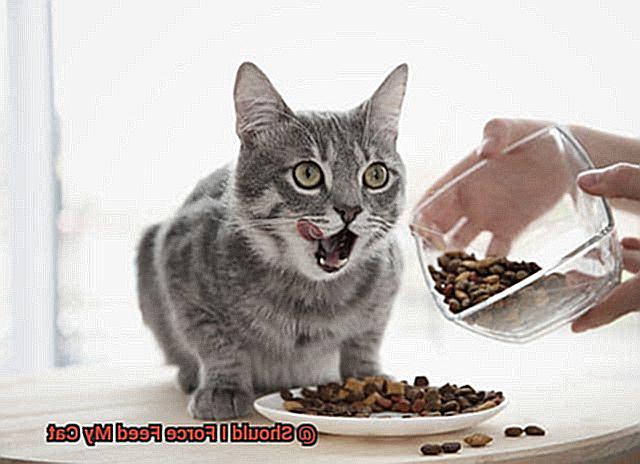
Selecting the Right Food
When selecting a food for syringe feeding, you can use high-calorie veterinary diets such as Hill’s a/d or Recovery, or a prescription liquid diet recommended by your veterinarian. It is also essential to use a syringe with no needle, typically 10-12 cc in size, and warm the food so that your cat does not feel discomfort.
Preparing Your Cat
Before beginning the feeding process, make sure your cat is calm and comfortable by wrapping them gently in a towel or blanket to prevent them from struggling or escaping.
Administering the Food
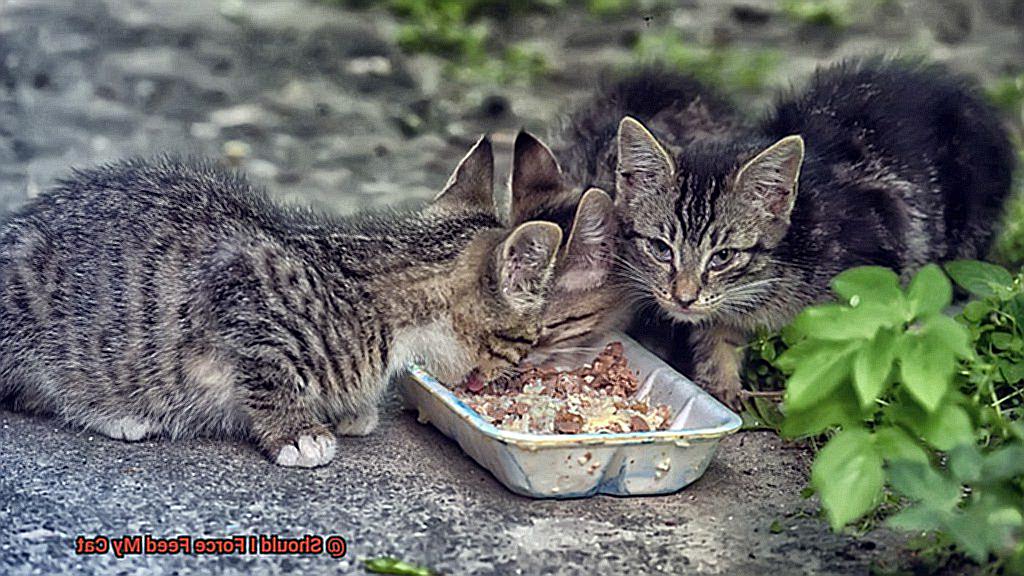
Fill the syringe with the appropriate amount of food and slowly insert it into the side of your cat’s mouth between their teeth and cheek.
Squeeze the plunger slowly to administer small amounts of food into their mouth, allowing enough time for them to swallow before giving more. Stop feeding if your cat shows any signs of distress, such as coughing, choking, or gagging.
Clean Up
After feeding is finished, clean the syringe and your cat’s face with a damp cloth to prevent bacterial growth and infection. It is crucial to follow your veterinarian’s recommended feeding schedule and amounts to prevent overfeeding or underfeeding.
Keep in mind that syringe feeding should only be done as recommended by veterinarians when cats refuse to eat on their own, and not as a long-term feeding method. Ensure that your cat is comfortable and calm during feeding and stop immediately if they experience any discomfort or distress.
Alternatives to Force Feeding
When your cat refuses to eat, it can be worrisome and you may be tempted to reach for the force feeding option. However, this should always be a last resort as it can be traumatic and lead to more health issues. Fortunately, there are alternatives to try before taking this route.
Veterinarians prescribe appetite stimulants in the form of pills, injections, or transdermal gels that can help boost your cat’s appetite.
Feeding tubes may also be an option for cats with medical conditions such as chronic kidney disease or cancer that prevent them from eating. These are surgically placed in their esophagus or stomach so you can feed them without having to force feed them.
You can also make food more appetizing by adding different flavors such as tuna juice or chicken broth. Smaller meals throughout the day may entice them more than one large meal; moist food is easier for cats to digest than dry food because it contains more water.
Before trying any of these methods, it’s important to speak with your veterinarian to ensure the best course of action for your cat’s specific needs is chosen.
ECPS4PFgRqg” >
Considerations for Dying Cats
Saying goodbye to a beloved cat is never easy, especially when they approach the end of their lives. At this time, cats often lose interest in food and it may be necessary to force-feed them in order to keep them comfortable. However, it is important to do so with caution and guidance from your veterinarian.
Your vet can help you decide when it’s time to start force-feeding while also providing tips on how to do it properly. When selecting food for your cat, choose something they like and that is designed for their nutritional needs.
Wet food may be easier for them to eat but dry food may be more convenient. When force-feeding your cat, use a syringe or soft feeding syringe and feed small amounts at a time.
It is also important to monitor your cat’s weight and overall health during this process. If there are signs of distress or weight loss, it may be time to consider other options such as hospice care or euthanasia.
Also Read: Should I Force Feed My Dying Cat? – 21Cats.org
Conclusion
Force-feeding a cat is not a decision to be taken lightly. It can be risky and can lead to further health issues if not done properly. Before attempting this method, consult your veterinarian for advice on an appropriate diet for your cat’s age and health.
Explore other options too, like appetite stimulants or offering different types of food. Also, make mealtime more inviting by hand-feeding your cat or creating a pleasant atmosphere at mealtimes.
Ultimately, the choice of whether or not to force-feed should be based on the individual needs of your pet and the advice of a vet.







